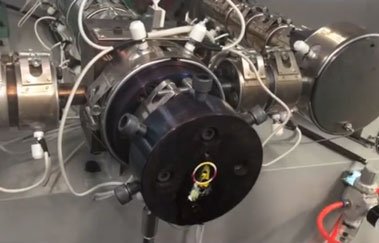March 18, 2019
The main areas of scrap or bottleneck on throughput in a typical plastic extrusion process is either during startup during the adjustment of the die head, during the cooling of the pipe (if you speed it up too much the pipe quality might deteriorate), in the saw or during socketing.
We will focus on the two main reasons.
 The first one is the Startup Scrap. This is caused during the adjustment of the die head to get the extrusion diameter and the wall thickness correct. The main reason of it happening is that the screws of the die head needs to be adjusted to get the pipe produced with the correct diameter and wall thickness. To make this happen, we typically wait for the pipe to be cooled, sawed and socketed and then measure if the dimensions are correct, then we adjust the screws. We repeat this cycle until we have a good produce. We can typically end up loosing tens of kgs of plastic in this adjustment (depending on the dimensions of the pipe). Material can be crushed and reused in different forms but in many cases the value of the plastic falls.
The first one is the Startup Scrap. This is caused during the adjustment of the die head to get the extrusion diameter and the wall thickness correct. The main reason of it happening is that the screws of the die head needs to be adjusted to get the pipe produced with the correct diameter and wall thickness. To make this happen, we typically wait for the pipe to be cooled, sawed and socketed and then measure if the dimensions are correct, then we adjust the screws. We repeat this cycle until we have a good produce. We can typically end up loosing tens of kgs of plastic in this adjustment (depending on the dimensions of the pipe). Material can be crushed and reused in different forms but in many cases the value of the plastic falls.
To ensure that we can have the die head installed exactly, whenever we want to produce the finished good, we need a database which maintains the dimensions and specifications of each finished good that we produce and with respect to the dimensions, firstly the pressure of tightening and secondly exact spatial location of each screw, that is used to tighten the die head in place (as in the picture). We get the pressure and spatial values empirically by doing the regular process with the regular waste that we always get. Once the database is populated empirically, whenever a pipe with similar dimensions needs to be produced, we set up the die head with the empirically found values of the screws of the die head and have reduced startup scrap.
This process can be taken to the next level by perhaps using Microsoft Halolens which joins the master data of what is being produced on what work center with the empirically found data of specifications of the screws of the die head. It then displays the required values for the operator to see and adjust the die head accordingly. The lens could also help with steps of the installation of the die head. This can save time for the operator by up to 50% of setup time and start up waste by more than 60%.
The second one is in the Warping of pipe during cooling. The factory wants to produce as much as possible and so would like to increase the speed of production as much as possible. Without gradual controlled rapid cooling, the pipe would come out with uneven cooling and the outside environment could warp it by rapid cooling.
 A closed loop with firstly temperature sensor(s), secondly an IFTTT (If This Then That) logic platform (can be done on various platforms, logic apps etc), with multiple logics around different temperatures and lastly control over the speed of water spray. Something like this is not expensive if the temperature sensor can send the data to the platform of choice directly. Finally the platform should be able to trigger events based on logic being successful. The control panel of the cooling bath should then increase / decrease the water spray based on temperature variance. In case the cooling bath is not so sophisticated and doesn’t have a control panel that can connect to the logic platform, then the tap of the water jet should be installed with a water filter that is controlled by the logic platform.
A closed loop with firstly temperature sensor(s), secondly an IFTTT (If This Then That) logic platform (can be done on various platforms, logic apps etc), with multiple logics around different temperatures and lastly control over the speed of water spray. Something like this is not expensive if the temperature sensor can send the data to the platform of choice directly. Finally the platform should be able to trigger events based on logic being successful. The control panel of the cooling bath should then increase / decrease the water spray based on temperature variance. In case the cooling bath is not so sophisticated and doesn’t have a control panel that can connect to the logic platform, then the tap of the water jet should be installed with a water filter that is controlled by the logic platform.
Typically, in factories running for decades, there is a lot of equipment which is outdated and cannot be connected to typical OT/MES platforms. In such scenarios getting 3rd party sensors that can connect to the OT/MES platform can be quick wins. The only challenge would be, as to what sensor to get and what data to get. Focusing on what to improve, or reduce, or increase etc is necessary to make a successful project. A word of caution would be to not end up having an extra platform just to migrate sensor data. Also, if purchasing an OT/MES platform, keep variety or possibilities of sensors in mind. A lot of sensor companies give everything for free and charge only per number of data points being sent to the platform. In a medium to large sized company, this can become really huge later.
 Achint Saran Bhatnagar is Process Owner for Manufacturing and Supply Chain, Europe (Technological Innovation), Mexichem, a provider of products and solutions across multiple sectors of industry and commerce, from construction and infrastructure to agriculture, healthcare, transportation, telecommunications, energy and more. He has a Bachelors in Mechanical Engineering from Dayalbagh, Agra and a Masters in Operations Management from SIBM, Bangalore. He has more than 1.5 decades of experience in Engineering, Supply Chain and Manufacturing across industries like Aerospace, Medical Electronics, Consumer Products, Hi-Tech and Manufacturing across various geographies in North America, Europe and Asia.
Achint Saran Bhatnagar is Process Owner for Manufacturing and Supply Chain, Europe (Technological Innovation), Mexichem, a provider of products and solutions across multiple sectors of industry and commerce, from construction and infrastructure to agriculture, healthcare, transportation, telecommunications, energy and more. He has a Bachelors in Mechanical Engineering from Dayalbagh, Agra and a Masters in Operations Management from SIBM, Bangalore. He has more than 1.5 decades of experience in Engineering, Supply Chain and Manufacturing across industries like Aerospace, Medical Electronics, Consumer Products, Hi-Tech and Manufacturing across various geographies in North America, Europe and Asia.
He will be happy to discuss or answer your questions sent on: asbhatnagar@gmail.com or on be reached on https://www.linkedin.com/in/achint-saran-b-1214337/
Scott Ellyson, CEO of East West Manufacturing, brings decades of global manufacturing and supply chain leadership to the conversation. In this episode, he shares practical insights on scaling operations, navigating complexity, and building resilient manufacturing networks in an increasingly connected world.